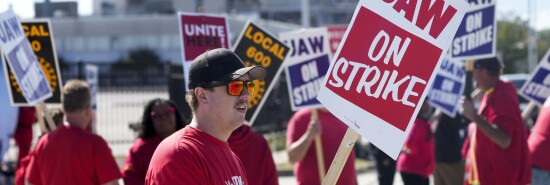
UAW strike: What the media won’t tell you about the strike
Sean Higgins
Video Embed
One of the things that liberal groups, unions included, have been good at is creating a narrative and selling that to the media. A case in point is the current United Auto Workers strike, which is being presented by the union as involving a bold new strategy of targeted walkouts. Don’t believe the hype. This is a case of the union lacking the resolve to do more.
Historically, labor strikes have been all-or-nothing propositions. The unions seek to shut down production and other business activity entirely. Without inflicting the maximum amount of pain on management, the union has little hope of gaining any concessions. This is why unions have always stressed the importance of solidarity to the cause. It’s why unions have always held that crossing the picket line is a betrayal of the workers.
UAW STRIKE: SHAWN FAIN GIVES NEW DEADLINE BEFORE MORE UNION WORKERS WALK OUT ON JOBS
That is not what is happening in the current UAW-automaker confrontation.
CNN explained, “The UAW referred to its targeted strike of three plants as a ‘Stand Up Strike,’ which it called a strategic ‘new approach’ to walking off the job.”
A Wall Street Journal story from Monday said the strike is “a rolling, slow-burn approach … designed to stymie the car companies’ factory operations as a way to gain leverage for the union.”
Reuters describes the strike as the “most ambitious U.S. industrial labor action in decades.”
A New York Times subhead declares, “The targeted strike is the first to hit Detroit’s Big Three automakers all at once.”
All of this sounds very dramatic, but take a closer look at what is actually happening. Closing three plants doesn’t mean that much when General Motors alone has a dozen plants in the United States. Fewer than 13,000 of the UAW’s 145,000 members have walked off the job. This is contrary to the whole concept of a strike. It’s like the old joke: “What if they held a war and nobody showed up?”
Incidentally, the three companies involved in the negotiations, GM, Ford, and Stellantis (the corporation including Fiat Chrysler), account for just 40% of U.S. auto production. U.S.-built foreign brands such as Toyota and Volkswagen, their factories mostly located in the South, account for the rest. Those plants aren’t unionized, so they’re not affected at all. For all of the headlines, the UAW strike will barely dent domestic production.
The Wall Street Journal reported that some in the UAW, including President Shawn Fain, pushed for a full strike, but “there was a simple financial calculation to consider: Such an option would rapidly drain the UAW’s $825 million fund that it uses to pay striking workers, likely depleting it within about two months.” In other words, the union itself doesn’t think it could hold out for long if it tried to shut all three companies. Hence the spin surrounding the current limited strike: UAW is trying to make a virtue out of necessity.
In past negotiations, UAW has tried to secure a deal with one of the three automakers ahead of the others and then use that agreement as a template for bargaining with the other two. That UAW didn’t try that this time suggests the union feared it could not wrestle even one company to the ground.
CLICK HERE TO READ MORE FROM THE WASHINGTON EXAMINER
It has been a rough decade for the UAW. The union’s two previous presidents exited as a result of corruption scandals. Fain only narrowly won his election to the top slot. The UAW isn’t fighting the political push for electric vehicles, even though that is certain to cost some members their jobs. The union’s efforts to organize factories in the South haven’t been successful.
At least the union can still count on most of the media to reflect its spin.
Sean Higgins is a research fellow with the Competitive Enterprise Institute.
